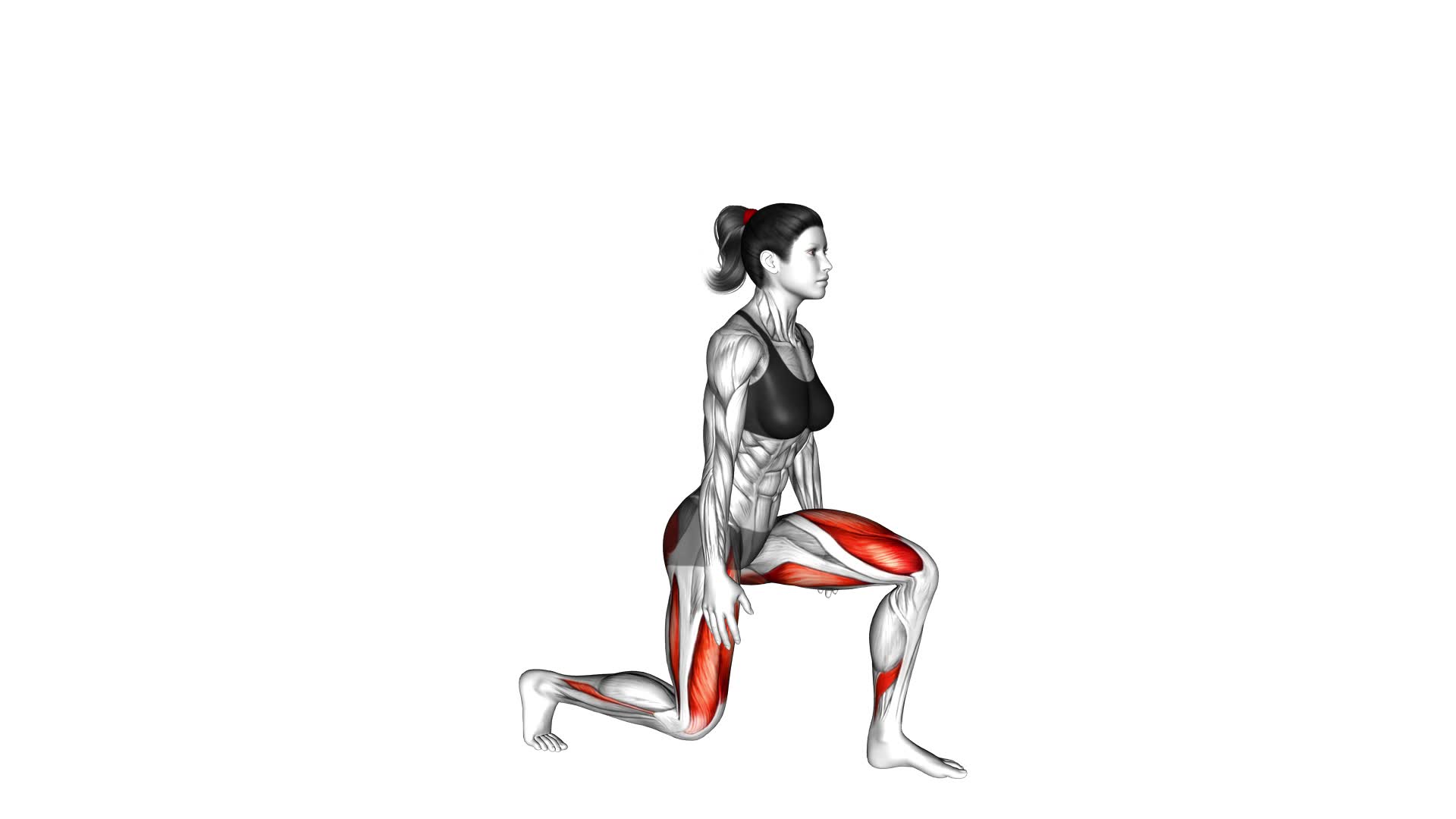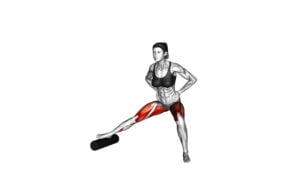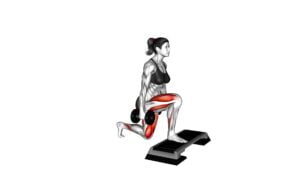Split Squat (female) – Video Exercise Guide & Tips

Are you looking for a new exercise to add to your routine?
Watch This Exercise Video
Check out this video guide and tips for the split squat! In just a few minutes, you'll learn:
- The benefits of this exercise
- Proper form and technique
- Variations to try
- Common mistakes to avoid
Plus, we'll give you some tips for making your workout more effective.
Get ready to challenge your lower body and achieve your fitness goals with the split squat. Let's get started!
Key Takeaways
- The split squat is a beneficial exercise for improving lower body strength, stability, and flexibility.
- It targets multiple muscle groups including the quadriceps, hamstrings, glutes, and calves.
- Proper form and technique are essential for maximizing the benefits and avoiding common mistakes.
- Variations and modifications can be made to make the exercise more accessible for beginners or to intensify the workout for advanced individuals.
Benefits of the Split Squat
You will experience significant improvements in lower body strength and stability by incorporating split squats into your workout routine. Split squats are a highly effective exercise that target multiple muscle groups in your lower body, including your quadriceps, hamstrings, glutes, and calves. By performing split squats regularly, you can expect to see noticeable gains in these areas.
One of the key benefits of split squats is their ability to improve balance. This exercise requires you to maintain stability while performing a unilateral movement, which helps to strengthen the muscles responsible for keeping you upright. As a result, you'll become more proficient at maintaining your balance in various activities and sports.
Another advantage of incorporating split squats into your routine is the increased hip flexibility they provide. During the exercise, your hip flexors are stretched, which can help to alleviate tightness and improve range of motion in this area. This is especially beneficial for individuals who spend a significant amount of time sitting or have sedentary lifestyles.
Proper Form and Technique
To perform the split squat exercise with proper form and technique, it's important to focus on maintaining a stable and balanced position throughout the movement. This will help you avoid injuries and improve your balance and stability.
Start by standing with your feet hip-width apart, and take a step forward with one foot, keeping your toes pointing forward. Lower your body by bending both knees, making sure your front knee is directly above your ankle and your back knee is hovering just above the ground.
Keep your torso upright and engage your core to maintain stability. As you push through your front foot, return to the starting position.
It's crucial to avoid leaning forward or letting your front knee go past your toes, as this can strain your knees and lead to injury.
Variations and Modifications
Now let's explore some variations and modifications of the split squat exercise.
If you're a beginner, there are modifications available to make it more accessible and manageable for you.
On the other hand, if you're looking for a challenge, advanced variations can be incorporated to intensify the exercise and push your limits.
Additionally, by modifying your stance or adding weight, you can target specific muscle groups and customize the split squat to your fitness goals.
Beginner-Friendly Modifications
For an easier version of the split squat exercise, incorporate beginner-friendly modifications and variations.
If you find the split squat challenging, there are modification options available to help you build strength and improve your form. One option is to use a chair or bench for support. Place your back foot on the chair, while keeping your front foot on the ground. This modification provides stability and reduces the amount of weight you have to lift.
Another alternative exercise is the static lunge, where you keep both feet on the ground and step forward into a lunge position. This exercise is less demanding on your balance and can be a good starting point for beginners.
By incorporating these modifications, you can gradually progress towards the standard split squat exercise.
Now, let's move on to advanced variations for a greater challenge.
Advanced Variations for Challenge
For a greater challenge, you can try incorporating advanced variations and modifications into your split squat exercise routine. These advanced modifications are designed to increase the difficulty of the exercise and further enhance your strength and stability.
One option is to add weight by holding dumbbells or a barbell while performing the split squat. This will increase the resistance and make your muscles work harder.
Another option is to elevate your front foot on a step or platform, which will require more balance and engage your muscles in a different way.
You can also try performing the split squat with a jump, adding an explosive element to the exercise.
These advanced variations will push your limits and help you achieve even greater results.
Now, let's move on to targeting specific muscle groups.
Targeting Specific Muscle Groups
To effectively target specific muscle groups in your split squat exercise, you can incorporate variations and modifications that engage and challenge those muscles even further. By adjusting the position of your feet, you can emphasize different muscles.
For example, a narrow stance will put more emphasis on your quads, while a wider stance will engage your glutes and hamstrings. Another modification you can make is to elevate your front foot on a step or block.
This will increase the range of motion and activate your glutes and hamstrings even more. To prevent injury, make sure to maintain proper form and alignment throughout the exercise. Keep your chest up, core engaged, and knees in line with your toes.
Common Mistakes to Avoid
Avoid these common mistakes when performing the split squat exercise to maximize your results and prevent injury:
- Incorrect foot placement: Ensure that your front foot is positioned far enough forward so that your knee stays directly above your ankle when you lower into the squat. Your back foot should be positioned far enough back so that your knee hovers just above the ground.
- Lack of stability: Maintain a strong and stable core throughout the exercise. Engage your abdominal muscles and keep your chest lifted to prevent any unnecessary strain on your lower back.
- Incorrect knee alignment: Make sure that your front knee stays in line with your toes as you lower into the squat. Avoid allowing your knee to collapse inward, as this can put excessive stress on your knee joint.
Tips for a More Effective Workout
Maximize the effectiveness of your split squat workout by incorporating these key tips.
To begin, let's address some common misconceptions. One misconception is that split squats only work the quads. While it's true that split squats primarily target the quads, they also engage other muscles such as the glutes, hamstrings, and core. To get the most out of your split squat workout, focus on maintaining proper form and engaging all of these muscle groups.
Another misconception is that you need fancy equipment to perform split squats. In reality, all you need is your body and a sturdy surface to stand on. However, if you want to add resistance and challenge your muscles further, you can incorporate dumbbells or a barbell. These equipment options provide added weight and can help you progress in your split squat workout.
In addition to addressing common misconceptions, here are some equipment recommendations to enhance your split squat workout. If you're a beginner, start with bodyweight split squats to master the movement and build strength. As you progress, you can add dumbbells or a barbell to increase the resistance. Remember to choose weights that challenge you but still allow you to maintain proper form.
By following these tips and incorporating the appropriate equipment, you can make your split squat workout more effective. Remember to listen to your body, take breaks as needed, and gradually increase the intensity of your workouts.
Happy split squatting!
Incorporating the Split Squat Into Your Routine
Start by adding the split squat to your routine two to three times a week. This exercise is great for improving balance and increasing flexibility. Here are three reasons why you should incorporate the split squat into your fitness regimen:
- Target multiple muscle groups: The split squat engages your quadriceps, hamstrings, glutes, and calves. By working these muscles, you can build strength and tone your lower body.
- Enhance stability and balance: Since the split squat requires you to maintain a split stance, it challenges your balance and stability. This can help improve your overall balance and reduce the risk of falls or injuries.
- Increase flexibility: The split squat promotes flexibility in your hip flexors and hamstrings. As you lower your back knee towards the ground, you stretch these muscles, which can enhance your range of motion and prevent tightness.
To perform a split squat, start by standing with one foot in front and the other foot behind you. Lower your back knee towards the ground while keeping your front knee bent at a 90-degree angle. Push through your front heel to return to the starting position. Repeat the exercise on the other side.
Incorporating the split squat into your routine won't only help you improve balance and increase flexibility but also contribute to a well-rounded lower body workout.
Frequently Asked Questions
How Many Calories Can I Burn by Doing Split Squats?
You can burn a significant amount of calories by doing split squats. This exercise engages multiple muscles in your lower body, making it a great calorie-burning workout. The exact number of calories burned will vary depending on factors such as your weight, intensity, and duration of the exercise.
Beginners can start with modifications like using a chair for balance or reducing the range of motion. Remember to consult with a fitness professional for personalized advice.
Can I Do Split Squats if I Have Knee or Hip Problems?
If you have knee or hip problems, it's important to exercise caution when doing split squats. These exercises can put strain on those areas, leading to further pain or injury.
It's recommended to modify the split squat or find alternative exercises that are more gentle on your knees and hips. Consult with a medical professional or a qualified fitness trainer who can guide you on suitable modifications or alternatives for your specific condition.
How Often Should I Include Split Squats in My Workout Routine?
To maximize the benefits of split squats in your lower body strength training routine, it's important to include them regularly. Aim to perform split squats two to three times a week, allowing for rest days in between.
By incorporating split squats into your workout routine, you can strengthen your glutes, quads, and hamstrings, improve balance and stability, and enhance overall lower body strength.
Remember to maintain proper form and technique for optimal results.
Are Split Squats More Effective for Building Leg Muscles Compared to Traditional Squats?
Split squats are a great exercise for building leg muscles. They can be more effective than traditional squats in targeting specific muscles, such as the glutes and hamstrings. Split squats also provide a greater range of motion, allowing for better muscle activation.
Additionally, they help improve balance and stability. So, if you're looking to strengthen your legs and target specific muscles, incorporating split squats into your workout routine can be beneficial.
Can Split Squats Help Improve My Balance and Stability?
Split squats can be a great way for you to improve your balance and stability. By focusing on one leg at a time, split squats challenge your coordination and force your stabilizer muscles to work harder.
This can be especially beneficial for athletes who need to maintain balance during dynamic movements. In addition to building leg strength, split squats offer a unique opportunity to enhance your overall stability and improve your athletic performance.
Conclusion
Incorporating the split squat into your workout routine can provide numerous benefits, such as improving lower body strength, stability, and flexibility.
By following proper form and technique, avoiding common mistakes, and making use of variations and modifications, you can ensure a more effective and safe workout.
Remember to listen to your body and adjust the intensity as needed.
With consistent practice, the split squat can help you achieve your fitness goals.

Author
Years ago, the spark of my life’s passion ignited in my mind the moment I stepped into the local gym for the first time. The inaugural bead of perspiration, the initial endeavor, the very first surge of endorphins, and a sense of pride that washed over me post-workout marked the beginning of my deep-seated interest in strength sports, fitness, and sports nutrition. This very curiosity blossomed rapidly into a profound fascination, propelling me to earn a Master’s degree in Physical Education from the Academy of Physical Education in Krakow, followed by a Sports Manager diploma from the Jagiellonian University. My journey of growth led me to gain more specialized qualifications, such as being a certified personal trainer with a focus on sports dietetics, a lifeguard, and an instructor for wellness and corrective gymnastics. Theoretical knowledge paired seamlessly with practical experience, reinforcing my belief that the transformation of individuals under my guidance was also a reflection of my personal growth. This belief holds true even today. Each day, I strive to push the boundaries and explore new realms. These realms gently elevate me to greater heights. The unique combination of passion for my field and the continuous quest for growth fuels my drive to break new ground.



